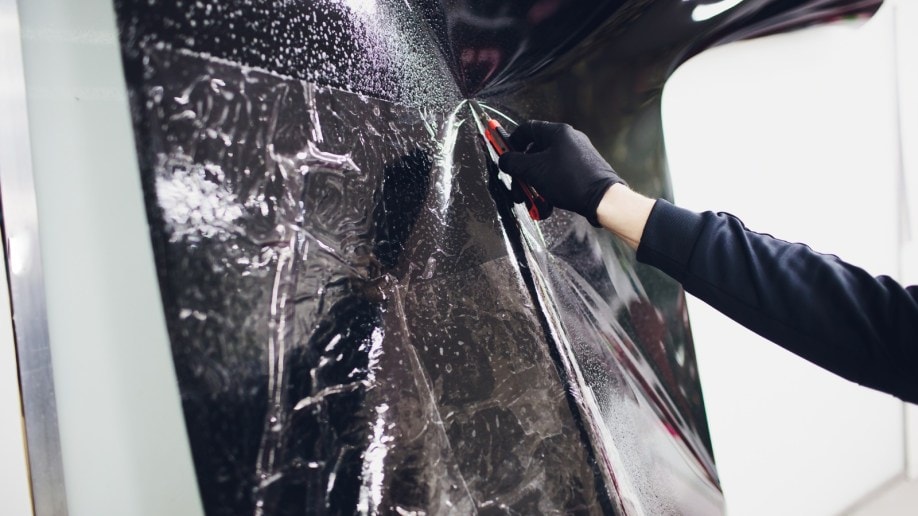AO Detail Window Tinting for Exceptional Film Application Quality
AO Detail Window Tinting for Exceptional Film Application Quality
Blog Article
Stay Cool and Comfortable: The Scientific Research Behind Window Tinting
Window tinting represents a sophisticated interaction of products science and practical application, functioning primarily via a thin movie that alters the means light connects with glass. As we discover the numerous systems and benefits associated with Window tinting, it comes to be noticeable that its impact prolongs beyond comfort, affecting power consumption and environmental sustainability.

How Window Tinting Functions
Window tinting operates via the application of a thin movie to the glass surface, which serves to customize the way light engages with the Window. This film is usually made up of polyester or other synthetic products and is embedded with different dyes and steels that influence light transmission and representation. When light strikes the tinted Window, a part of it is soaked up, while some is mirrored, and the rest passes with.

Additionally, Window tinting can boost personal privacy and minimize glare, making spaces more comfortable without jeopardizing exposure. The efficiency of Window tinting varies based upon factors such as the kind of film utilized, the angle of light occurrence, and the attributes of the glass. Comprehending these concepts is vital for choosing the suitable color for particular requirements and environments.
Advantages of UV Protection
One of the most significant benefits of Window tinting is its ability to supply efficient UV protection. Ultraviolet (UV) radiation from the sun is a well-documented cause of skin damage, consisting of early aging and a raised threat of skin cancer cells (AO Detail Window Tinting). By incorporating Window tinting, individuals can dramatically reduce their exposure to dangerous UV rays, improving their general health and wellness and health
Premium Window film can block approximately 99% of UV radiation, producing a safer setting for occupants. This protection is especially useful for those that spend expanded periods inside, such as workplace employees or homeowners in sunny environments. UV exposure can lead to fading of interior furnishings, art work, and flooring, resulting in expensive replacements. Window tinting helps minimize these impacts, preserving the aesthetic appeal and stability of interior rooms.
Additionally, numerous Window film offer a twin benefit by reducing glare, which can improve convenience and performance. Generally, the implementation of Window tinting functions as a proactive procedure to safeguard health and prolong the life of valued possessions, making it a prudent financial investment for both commercial and residential setups.
Temperature Guideline Systems
Effective temperature level guideline is an essential advantage of Window tinting, as it contributes to an extra comfortable interior setting. Window film are developed to show, absorb, and send differing degrees of solar energy, permitting a regulated management of warm entering a room. This policy is largely accomplished via the optical properties of the color, which can obstruct a significant portion of infrared radiation while allowing noticeable light to pass through.
By minimizing warm gain throughout warmer months, Window tinting helps maintain a secure indoor temperature level, reducing the dependence on air conditioning systems. On the other hand, throughout colder months, specific types of Window film can help retain warmth within the building. This twin performance guarantees that residents experience regular comfort despite exterior climate conditions.
Additionally, Window tinting can reduce temperature fluctuations triggered by direct sunlight, reducing the danger of hot areas near home windows. Consequently, the total indoor climate comes to be a lot more balanced, improving passenger fulfillment and productivity. The scientific research behind these temperature guideline devices highlights the value of Window tinting as a sensible service for enhancing living and workplace.
Enhancing Energy Effectiveness
Power efficiency is considerably enhanced with the application of Window tinting, further structure upon the benefits of temperature level regulation. By reducing the quantity of solar heat that enters a structure, Window tinting minimizes the reliance on cooling systems, leading to lower power consumption. This not just adds to decreased utility bills but also reduces greenhouse gas discharges associated with power production.
In addition to warmth decrease, Window tinting likewise assists maintain steady interior temperature levels, which can minimize the work on heating unit throughout cooler months. This double benefit of controling both heat gain and loss lead to a much more reliable general energy performance for industrial and domestic residential or commercial properties alike.
Furthermore, Window tinting can secure furnishings and insides from damaging UV rays, which can cause fading and damage in time. By protecting the integrity of indoor rooms, homeowner can minimize the frequency of repair work and substitutes, even more improving price savings.
Eventually, including Window tinting as component of an energy-efficient method not just maximizes convenience however likewise advertises sustainability, making it a sensible financial investment for those seeking to boost their power footprint.
Picking the Right Color
Choosing the ideal Window color is critical for taking full advantage of the advantages of this improvement. The choice of tint can dramatically impact power efficiency, looks, and personal privacy. When thinking about Window tinting, it is important to examine the different sorts of film readily available, including dyed, metalized, and ceramic alternatives. Dyed film give a basic level of heat decrease and personal privacy but might discolor with time. Metalized film provide boosted heat click for info denial and boosted resilience as a result of the reflective homes of metal layers. Nonetheless, they might hinder electronic signals.
Ceramic Window film stand for an exceptional selection, integrating exceptional thermal insulation with low reflectivity, thereby protecting a clear view. It is additionally important to think about the lawful laws concerning color darkness in your area, as conformity is important to prevent fines and guarantee safety and security.
Furthermore, assessing your details needs-- such as UV defense, glow decrease, and privacy-- will direct your option procedure. Consulting with a professional installer can offer important understandings and recommendations tailored to your circumstance. Eventually, the right Window color balances functionality and visual appeals, contributing to an energy-efficient and comfortable atmosphere.
Conclusion

Window tinting stands for an innovative interaction of products science and practical application, functioning mainly via a thin film that modifies the way light engages with glass.Window tinting runs her latest blog via the application of a slim film to the glass surface area, which serves to modify the means light engages with the Window. By including Window tinting, people can substantially decrease their direct exposure to harmful UV rays, improving their overall health and wellness and wellness.
Moreover, Window tinting can alleviate temperature level fluctuations caused by straight sunlight, decreasing the danger of warm spots near windows. When thinking about Window tinting, it is essential to review the various types of film available, consisting of colored, metalized, and ceramic options.
Report this page